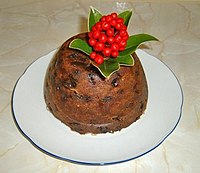Pudding


- In the British Isles, and some Commonwealth countries, pudding is the common name for dessert.
Pudding is either of two general types of the second deriving from the first. Which of these foods are regarded as puddings differs between geographical regions.
First type:
- The older puddings are foods that are presented in a solid mass formed by the amalgamation of various ingredients with a binder, which might include batter (as in Yorkshire pudding), blood (black pudding), eggs (bread pudding), or a mixture of suet and flour or some other cereal (plum pudding). These kinds of puddings can be either baked, steamed, or boiled. This type of pudding is still common in various places, especially the British Isles, and can be either a main-course dish or a dessert.
- As a main course, boiled puddings were a common meal on board ships in the British Navy in the 18th and 19th centuries, and the usual manner in which daily rations of flour and suet were prepared.
- Many dessert puddings of this type resemble cakes, but are moister and usually served in chunks rather than slices in a bowl, with an accompaniment such as custard or ice cream. This is the type of dish ordinarily meant by the word "pudding" in Australia (e.g. christmas pudding or the British form of chocolate pudding). While some other dishes are labelled as puddings in Australia (e.g. rice pudding or instant pudding, which belong to the second category, below), in such cases the word is almost always qualified with an adjective.
Second type:
- The newer type of pudding is almost exclusively a dessert-type dish. The usual form is for milk with sugar and other added ingredients to be solidified by means of some gelling or structural agent, including cornstarch, gelatin, eggs, tapioca (cassava), and other starches. Forms of these include custard and blanc-mange. They are available in forms which require cooking or in instant form. Related foods include gelatin desserts such as Jell-O and aspics.
Suet puddings:
- Steamed pies consisting of a filling completely enclosed by suet pastry are also known as puddings. These may be sweet or savoury: for example steak and kidney pudding.
Specific types of pudding
First type, Savoury
- Black pudding
- Haggis, according to poet Robert Burns
- Kugel
- Red pudding
- White pudding
- Yorkshire pudding
First type, Dessert
- Bread pudding
- Bread and butter pudding
- Carrot pudding
- Cheshire pudding
- Chocolate pudding (British style)
- Christmas pudding (also called plum pudding)
- Clootie dumpling
- Jam Roly-Poly
- Spotted dick
- Sticky date pudding
- Sticky toffee pudding
- Summer pudding
Second type
- Blanc-mange
- Chocolate pudding (American/Asian style)
- Custard
- Hasty pudding
- Haupia (Hawaiian coconut pudding)
- Mango pudding
- Rice pudding
- Tapioca pudding
Not yet classified
Miscellaneous desserts
In these examples, the word pudding appears to be the British sense meaning dessert, rather than puddings as defined in this article.
External links
- Pudding Recipes
- The Pudding Club - dedicated to preserving the tradition of great British puddings.
